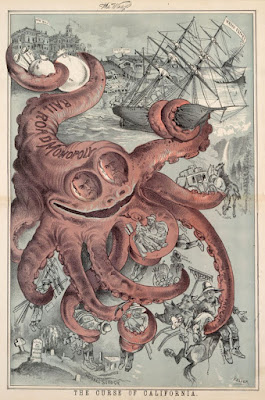 |
| One of Punch's occasional sallies into the surreal (1873). |
 |
| "Dream of the Fisherman's Wife" (1814) Woodblock print by Katsushika Hokusai. |
As sensational as nineteenth-century tentacle porn is, the go-to answer for steampunk's fascination with octopi is Jules Verne's classic science fiction novel, "Twenty Thousand Leagues Under the Sea" (1870), in which the octopus-like kraken symbolizes the industrial revolution. I don't deny that Verne's work was influential, but he wasn't the first writer to use the octopus as a symbol of the industrial revolution. Indeed, Verne's monster references the earlier monster in Victor Hugo's "Toilers of the Sea" (1866).
 |
| Ink wash painting by Victor Hugo (1866). |
 |
| G. Frederick Keller's "The Curse of California." The Wasp on August 19, 1882. A likely origin of the depiction of the Southern Pacific Railroad monopoly as an octopus in Frank Norris's novel. |
"This Cartographic Land Octopus can be a representation of fear and revolution. Once a reader sees this sea creature image, it gives a feel of horror and fear. Black propaganda maps used this Cartographic Land Octopus to portray how a country takes power over other nation by its tentacles spread over the other areas. Its tentacles can be the reason why this creature is Cartography’s favourite land monster. It represents evil spread over the lands and its head, the center of wicked intelligence" source.Cartographic propaganda dates back to the Middle Ages and kraken appear on maps for much of that history. The difference between the kraken and the land octopus is location and function. Cartographers used kraken to fill up empty or unknown areas of water. The first land octopus didn't appear until Fred Rose's "Serio-comic war map for the year 1877." Rose's land octopus portrayed the Russian Empire as stretching out its tentacles to take control of Europe. Russia continued to appear as an octopus on propaganda maps through the Second World War.
 |
| Fred Rose's "Serio-comic war map for the year 1877." |
 |
| Imperial Hendecapus (1888). |
Considering its history in representing imperialism and the industrial revolution, the octopus lends itself very well to contemporary Victorian and Steampunk culture. Contemporary Victorian-style interpretations of the octopus visually celebrate the industrial revolution as a weird and fancy part of our past, which is very Victorian.
See more images of land octopi in Popular Science's "A Brief History of Octopi Taking Over the World."
Follow me on Twitter @TinyApplePress and like the Facebook page for updates!
